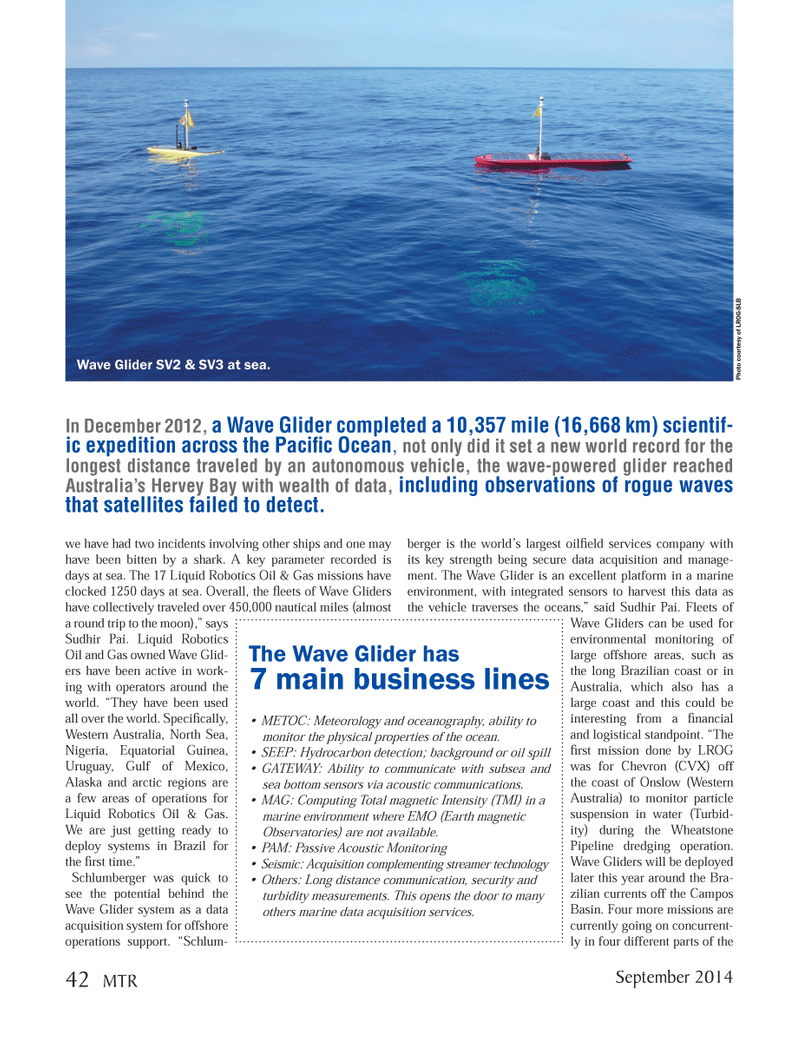
Page 42: of Marine Technology Magazine (September 2014)
Ocean Observation: Gliders, Buoys & Sub-Surface Networks
Read this page in Pdf, Flash or Html5 edition of September 2014 Marine Technology Magazine
we have had two incidents involving other ships and one may have been bitten by a shark. A key parameter recorded is days at sea. The 17 Liquid Robotics Oil & Gas missions have clocked 1250 days at sea. Overall, the fl eets of Wave Gliders have collectively traveled over 450,000 nautical miles (almost a round trip to the moon),” says
Sudhir Pai. Liquid Robotics
Oil and Gas owned Wave Glid- ers have been active in work- ing with operators around the world. “They have been used all over the world. Specifi cally,
Western Australia, North Sea,
Nigeria, Equatorial Guinea,
Uruguay, Gulf of Mexico,
Alaska and arctic regions are a few areas of operations for
Liquid Robotics Oil & Gas.
We are just getting ready to deploy systems in Brazil for the fi rst time.”
Schlumberger was quick to see the potential behind the
Wave Glider system as a data acquisition system for offshore operations support. “Schlum- berger is the world’s largest oilfi eld services company with its key strength being secure data acquisition and manage- ment. The Wave Glider is an excellent platform in a marine environment, with integrated sensors to harvest this data as the vehicle traverses the oceans,” said Sudhir Pai. Fleets of
Wave Gliders can be used for environmental monitoring of large offshore areas, such as the long Brazilian coast or in
Australia, which also has a large coast and this could be interesting from a fi nancial and logistical standpoint. “The fi rst mission done by LROG was for Chevron (CVX) off the coast of Onslow (Western
Australia) to monitor particle suspension in water (Turbid- ity) during the Wheatstone
Pipeline dredging operation.
Wave Gliders will be deployed later this year around the Bra- zilian currents off the Campos
Basin. Four more missions are currently going on concurrent- ly in four different parts of the
Wave Glider SV2 & SV3 at sea.
Photo cour tesy of LR
OG-SLB
In December 2012, a Wave Glider completed a 10,357 mile (16,668 km) scientif- ic expedition across the Pacifi c Ocean, not only did it set a new world record for the longest distance traveled by an autonomous vehicle, the wave-powered glider reached
Australia’s Hervey Bay with wealth of data, including observations of rogue waves that satellites failed to detect.
The Wave Glider has 7 main business lines METOC: Meteorology and oceanography, ability to monitor the physical properties of the ocean. SEEP: Hydrocarbon detection; background or oil spill GATEWAY: Ability to communicate with subsea and sea bottom sensors via acoustic communications. MAG: Computing Total magnetic Intensity (TMI) in a marine environment where EMO (Earth magnetic
Observatories) are not available. PAM: Passive Acoustic Monitoring Seismic: Acquisition complementing streamer technology Others: Long distance communication, security and turbidity measurements. This opens the door to many others marine data acquisition services.
September 2014 42 MTR
MTR #7 (34-49).indd 42 8/27/2014 9:39:10 AM

 41
41

 43
43
